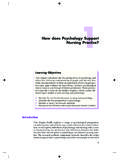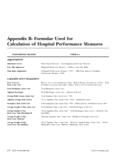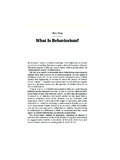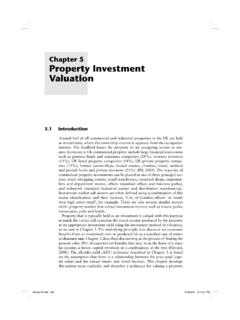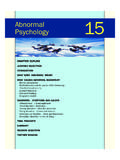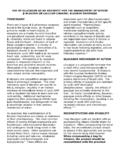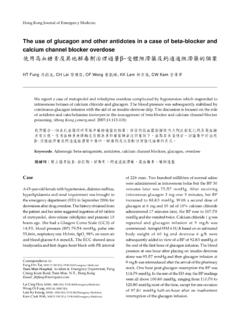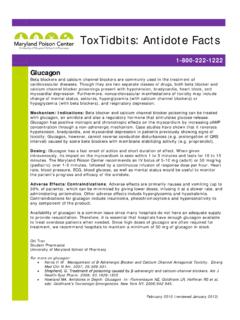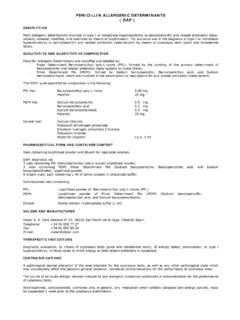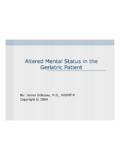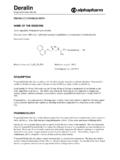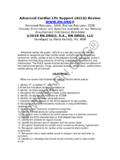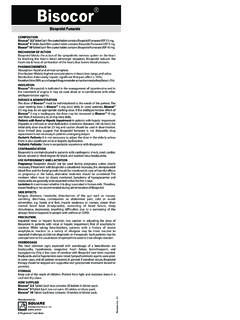Transcription of ABCDE SYSTEM (ADVERSE EVENTS OF TYPE A, B, C, …
1 1 AABCDE SYSTEM ( adverse EVENTS OF TYPE A, B, C, D, E)HISTORYH urwitz and Wade proposed many years ago four categories of adverse EVENTS (Br Med J 1969; Mar 1(643):531). The first two mechanisms have been combinedunder category A and the second two mechanisms under category B. Side effect Excess effect Allergy (hypersensitivity) IdiosyncrasyDeSwarte classified adverse drug reactions (ADRs) into eight categories (ArchIntern Med 1986;146:649): Overdose Side effect Secondary, indirect effect Interaction Intolerance Idiosyncrasy (primary toxicity) Allergy Pseudoallergy (anaphylactoid)Note that overdose and interaction are risk factors and the indirect or second-ary effect is a physiologic consequence. Further information can be found inMeyboom (PEDS 1997;16:355) and in Royer (PEDS 1997;6:S43).TYPE A adverse EVENTR awlins and Thompson of Newcastle, Great Britain, have classified adverseevents into type A and type B on the basis of the mechanism of action.
2 A type Aevent is one that is due to an extension of the active pharmacologic propertiesof the drug (A indicates augmented). They are also called predictable or anticipatedevents. They are generally less severe and more frequent than type B EVENTS . Thisaugmented pharmacologic action may occur at the targeted receptors or atother nontargeted receptors producing lateral effects, parallel effects, or side are usually detected during the clinical trials done before are two subclasses: Exaggerated Desired EffectThe undesirable exaggeration of a desired pharmacologic effect after a normal dosein a susceptible subject or after a higher than normal dose. This results fromthe excess stimulation of targeted receptors by the therapeutic agent. Orthos-tatic hypotension with an antihypertensive, daytime somnolence after a seda-tive-hypnotic taken for sleep, and hypoglycemic shock after insulin areexamples of this phenomenon.
3 Undesired EffectThe appearance of an undesired pharmacologic effect, known as lateral or parallelstimulation, can be seen after a normal dose or a higher than normal dose in asusceptible subject; it is due to the stimulation of untargeted receptors by thetherapeutic agent. Examples include constipation due to morphine, gas-trointestinal irritation with nonsteroidal antiinflammatory drugs (NSAIDs),hair loss from chemotherapy, and loss of libido with B adverse EVENTA type B reaction is one that is not due to an extension of the active pharmaco-logic properties of the drug; the B indicates bizarre. They are called pharmacologi-cally unexpected, unpredictable, or idiosyncratic adverse are two subclasses: ImmunologicAn allergic or hypersensitivity reaction occurs as a result of an pseudoallergy or anaphylactoid reaction is the result of a mechanism involvingthe release of the same mediators released during an immunologic reactiondue to immunoglobobulin E (IgE).
4 Such reactions can occur withradiocontrast agents, NSAIDs, for example.(See ALLERGY, DRUG) IdiosyncraticThe term idiosyncratic is often used in a broad sense to designate qualitativelyabnormal adverse reactions that occur in a given individual and whosemechanism is not yet understood. These reactions are usually quite rare andin some cases may be due to a genetic or acquired enzyme abnormality withthe formation of toxic metabolites. This is also known as primary enzyme abnormalities may produce adverse reactions such as thehemolytic anemia due to glucose-6-phosphate dehydrogenase (G6PD) enzyme abnormalities result from a drug effect that produces enzymeinhibition or C, D, and E are not mechanisms but characteristics of their manifesta-tions; they are not referred to frequently in the literature. The letter C refers tocontinuous, chronic. Type D refers to delayed in appearance, making them difficultto diagnose.
5 Type E refers to end of POTENTIAL (See PHARMACODEPENDENCE)ACCEPTABILITY (OF AN adverse DRUG REACTION)In drug surveillance, an adverse drug reaction (ADR) is deemed acceptablewhen its frequency and severity are sufficiently compensated for by the fre-quency and magnitude of the therapeutic benefit of the drug. This is neces-sarily a value judgment. Similarly to the benefit/risk judgment made inclinical therapeutics for an individual patient, a benefit/risk judgment canbe made in pharmacovigilance from a population point of view. When anADR that is clearly greater than the drug benefit expected occurs ( , se-vere gastrointestinal (GI) bleeding with a mild analgesic), the ADR is re-ferred to as alarming. On the other hand, a headache, for example, seen withan acquired immunodeficiency syndrome (AIDS) or cancer medicationwould be deemed Potential2In pharmacotherapy, whenever a product is incorrectly prescribed or used, thebenefit expected is considered to be zero for the calculation of the benefit/riskratio.
6 An example would be the prescription of an antibiotic for a simple cold ofviral origin, in which case no ADR would be acceptable since there is no phar-macologic benefit to be also that in the pharmaceutic sciences, the term acceptability is used in an-other sense, namely, that of the quality of the galenic form in regard to ease ofadministration (timing, mode of administration, volume of the tablet, taste ofthe suspension, packaging, etc.).IN CLINICAL PRACTICEIn the course of pharmacologic therapy, the clinician makes a decision in regardto the acceptability of an ADR and decides whether or not to modify the treat-ment in a given patient. Here are four the occurrence of an ADR: In a patient with newly diagnosed hypertension,the practician may hesitate between prescribing a thiazide diuretic and abeta-blocker. However, the presence of asthma in the patient makes the beta-blocker unacceptable.
7 The thiazide is thus chosen in order to prevent the riskof possible bronchospasm with the the occurrence of an ADR: A hypertensive patient has an acute episode ofgout after having started treatment with a thiazide, which now makes thistreatment unacceptable. The clinician substitutes a the occurrence of an ADR but before the occurrence of the desired beneficial effect:A patient suffering from prostatitis has been taking an antibiotic. There is noimprovement in his symptoms and he is now complaining of daily abdominaldiscomfort associated with his medication. The prescriber would be morelikely to stop the drug, deeming the ADR unacceptable, because the prostati-tis was not the occurrence of an ADR and after the occurrence of the desired beneficial effect: Ahypertensive patient tolerates neither thiazides nor beta-blockers. Her bloodpressure is well controlled with an angiotensin converting enzyme (ACE) in-hibitor, but she has an occasional mild dry cough.
8 After a discussion betweenthe prescriber and the patient, the two agree that the mild cough is acceptablesince good pharmacologic control of her blood pressure has been A POPULATION LEVELH ealth authorities perform their duties of drug surveillance during the two peri-ods of development of a new product:Before marketing authorization: The authorities responsible for the approval of anew drug must examine the dossier submitted and may refuse to approve thedrug if the risks observed during clinical development outweigh the degreeof therapeutic innovation, especially when safer alternative therapies are al-ready marketing authorization: After the marketing of a drug, health authoritiesmay take various regulatory measures, ranging from restrictions on the use ofthe drug to its complete withdrawal from the market. These measures aretaken when the risk, first seen in the spontaneous ADR reports, is confirmedby a pharmacovigilance evaluation and when this risk clearly outweighs theexpected pharmacologic BENEFITSS ince the comparison of risk to benefit is used during safety investigations andduring the selection of regulatory measures, let us review the various types ofbenefits attainable from a medication:Overdose correction: antidotes, : contrast agents, radioisotopes, : antibiotics, antivirals, gene : prevention of cerebrovascular or cardiovascular accidents byhyperlipidemics, antihypertensives, platelet antiaggregants, and anti-arrhythmics.
9 In prophylactic pharmacotherapy one must always make the dis-tinction between a pharmacologic effect, which serves as an intermediatemeasure or end point (surrogate marker) used in many clinical trials, and atherapeutic (clinical) benefit, which can often be found only in large, long-term, costly, and relatively rarely performed clinical trials. For instance, themeasurement of cholesterol levels in a short-term trial using a new choles-terol lowering agent is a surrogate end point, whereas the measurement ofmyocardial infarcts, cerebrovascular accidents, and death in a long-term sur-vival study represents the clinical therapy: hormones ( , insulin), electrolytes ( , potassium),metabolites ( , glucose), blood products, vitamins ( , B12), and treatments: analgesics, antiemetics, of side effect: use of antihistamines to counter neuroleoptically in-duced RISKThe risk of an adverse drug reaction (ADR) becomes acceptable when the ex-pected benefit is greater than the likelihood that the ADR will occur.
10 This is amedical judgment made by the regulatory authorities when approving a newdrug, by the physician when prescribing the drug, and by the patient when tak-ing it. It is based on the frequency and severity of the ADR(s), the frequencyand magnitude of expected benefit, and the severity of the the context of pharmacovigilance, accountability refers to the responsibility ofeach person in the development, research, and use of drugs to ensure that theyare used in a rational, efficacious, benevolent, and safe manner. There are com-plex and multiple interdependencies and responsibilities in this chain affectingall parties involved to varying degrees: pharmaceutical companies, legislators,health authorities, medical educators, editors of medical journals, prescribers,sellers, dispensers, and users. The goal of all of the people and organizations in-volved is to prevent adverse drug reactions (ADRs) due to negligence, impru-dence, errors, or irregularities, as these ADRs are preventable (seeCAUSALITY, Legal).




